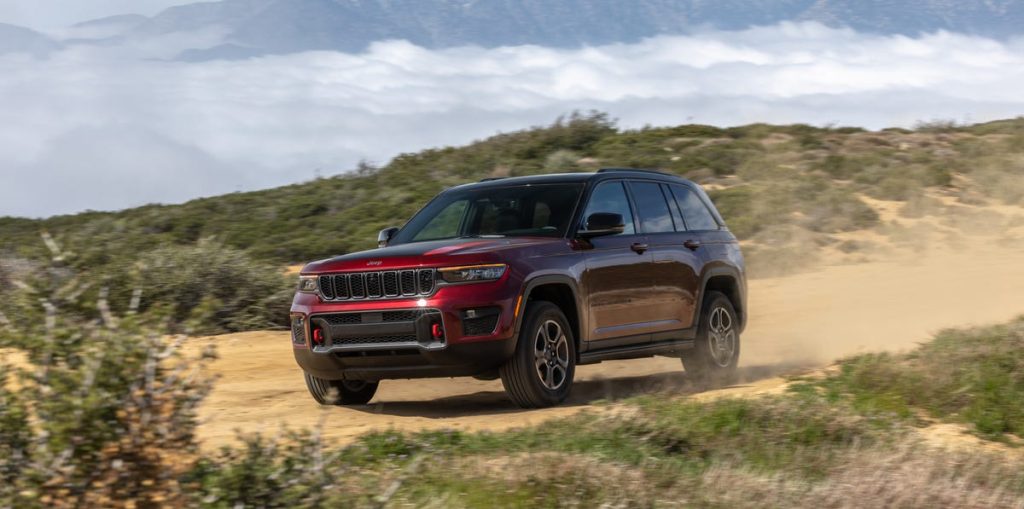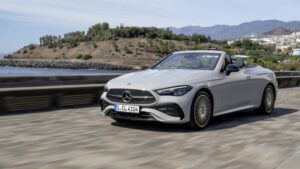Tested: 2022 Jeep Grand Cherokee Trailhawk V-6 Does Jeep Things

With the Jeep Grand Cherokee, the names tell much of the story: Summit Reserve and Trailhawk. The former sounds more like a locally produced Merlot than an off-road machine. It’s the wine country touring conveyance of the Grand Cherokee lineup. That’s largely borne out by a quick scan of its pavement-oriented tire and clearance specs, not to mention our test results. The Jeep Grand Cherokee Trailhawk, on the other hand, sounds like a machine that wants nothing more than a dirt bath. It looks like a more promising off-highway partner on paper, too, so we had to lay our hands on one to better explore its capabilities.
We had driven the new Grand Cherokee Trailhawk before, during the product launch event in Moab, Utah. It acquitted itself extremely well on a short rough-and-tumble off-road course just outside of town. But when we say “just outside of town,” we mean no more than two miles from home base. Very little pavement driving was involved on the Trailhawk portion of the program, so we didn’t learn much about living with it day-to-day.
Sean C. RiceCar and Driver
At $56,030 the Trailhawk 4×4 sits just above the volume-selling Limited and below the Overland in the Grand Cherokee pricing and equipment hierarchy. That price gives you standard full-time four-wheel drive, air suspension and adaptive dampers, power heated-and-ventilated leather front seats, a heated steering wheel, and heated rear seats. The logically arrayed controls are laid out across a backdrop of piano black, which means that fingerprints seemingly come standard, with faint scratches optional if you use the wrong type of cleaning cloth. Such marks were so obvious on our test vehicle’s flip-down cupholder cover that we simply left it open. Can we reel in this trend, please?
You can also outfit a Trailhawk with options found higher up the food chain such as the Uconnect 5 10.1-inch display screen with navigation, a dual-pane panoramic sunroof, a front passenger display screen, and a full suite of advanced driver-assist features and luxury appointments. Our test sample had all that and more, pushing its price to at an eye-watering $65,535. It would have been $3795 pricier if we’d added the optional 5.7-liter V-8, and the Trailhawk is also available with the 4xe plug-in-hybrid powertrain at a starting price of $64,280.
HIGHS: Impressive off-road clearance and articulation, civilized ride and handling, high-end options available.
Sean C. RiceCar and Driver
Our test sample instead had the 3.6-liter Pentastar V-6, which is such an impressive base engine that it comes standard in all models—up to and including the Summit Reserve. Its 293 horsepower and 260 pound-feet of torque feel more than adequate in the Trailhawk, even off-road, where low-range gearing multiplies the torque by a factor of 2.72. Its output flows through the same smooth-shifting eight-speed automatic and 3.45-to-1 final-drive gearing as the Summit Reserve, so it’s no surprise that its 7.7-second 60-mph sprint, 15.8-second quarter-mile run, and 5.5-second 50-to-70-mph passing times are within 0.2 to 0.3 second of the results we measured with the Summit Reserve.
The Trailhawk times are fractionally slower, which makes sense when you consider the extra tread squirm that comes with its knobbier 265/60R-18 Goodyear Wrangler Territory All-Terrain tires. We’re frankly surprised that the Summit Reserve’s wider, pavement-oriented 275/45R-21 Continental CrossContact LX Sport rubber didn’t give it a bigger advantage. We saw a larger performance gap in our braking and cornering tests, however, where the Trailhawk drew out its 70-mph stop to 185 feet versus 163 feet for the Summit Reserve, and at the skidpad managed just 0.78 g of stick compared to the Summit Reserve’s more robust 0.85 g.
Sean C. RiceCar and Driver
LOWS: Base price is $7300 higher than last year, off-road tires diminish lateral grip and worsen stopping distance, enough with the piano black interior trim already.
Such at-the-limit deficiencies don’t amount to much in the real world, though, mainly because off-road-oriented customers expect as much. Besides, the all-terrain tires don’t undermine the predictability and fluidity of the steering because the Trailhawk benefits from the same revised multilink (single upper control arm and dual lower link) front suspension and improved steering tuning that’s found across the Grand Cherokee lineup. Also, the Trailhawk’s standard air springs and adaptive dampers pair nicely with the taller sidewalls of its 18-inch Wranglers to take the edge off cracks and seams in the pavement.
Sean C. RiceCar and Driver
Off-road hijinks are what the Trailhawk was built to handle, and on that front it’s not only much better-equipped than the Summit, it also eclipses the previous-gen Trailhawk. It starts at the chin. The Summit’s street-oriented front fascia only offers 28.2 degrees of approach clearance in the suspension’s highest off-road setting, and last year’s Traihawk was little better at 29.8 degrees. Its front air dam, though, was designed to be removable, resulting in 36.1 degrees if you were willing to: a) go to the trouble and, b) live with the unsightly result. Meanwhile, this new Trailhawk’s reworked front end delivers 35.7 degrees of clearance out of the box, with no need to remove anything.
The new Trailhawk also sets itself apart from last year’s model in that its front anti-roll bar can be disconnected, just like a Wrangler Rubicon’s. We measured its suspension articulation on our test ramp and recorded a ramp-travel index (RTI) score of 365 with the bar connected and 478 with it disconnected, a whopping 31-percent increase that resulted from an extra 4.5 inches of suspension flex across the front axle. We haven’t measured the outgoing Trailhawk, but it would likely score lower because the new Trailhawk’s revised front suspension also includes an extra inch of suspension travel.
Sean C. RiceCar and Driver
These two characteristics are why the new Trailhawk excelled in Moab and on our own trails near home. To surmount an obstacle, you must first clear it at the nose. After that, the traction provided by the all-terrain tires and low-range gearing in the Quadra-Drive II full-time four-wheel-drive system helps it clamber up the face, at which point the available (and cleverly disguised) Mopar rock rails protect the lower edges of the body as the suspension flexes to keep all four tires connected to earth. When that’s no longer possible, the Quadra-Drive II system’s electronically controlled limited-slip differential can shift as much as 100 percent of the rear-axle torque to the tire that’s still on the ground. Forward visibility is maintained throughout thanks to the Trailhawk’s standard front-facing off-road camera, which can be cleaned with a washer system should you manage to splatter it with mud.
Clearly, not everyone needs this sort of off-road performance, even in a Jeep Grand Cherokee. But the Trailhawk formula exists precisely because there are a good number of Grand Cherokee customers who want their Jeep to do Jeep things. On this front, the Grand Cherokee Trailhawk delivers, and it delivers a higher level of that sort of capability quite seamlessly. Its knobbier tires may dull its ultimate dynamic performance a bit, but the wide-ranging enhancements made to the entire Grand Cherokee lineup ensure that its on-road manners and general civility are thoroughly agreeable. Enough, even, for a trip to Merlot country.
A car-lover’s community for ultimate access & unrivaled experiences. JOIN NOW
This content is created and maintained by a third party, and imported onto this page to help users provide their email addresses. You may be able to find more information about this and similar content at piano.io






